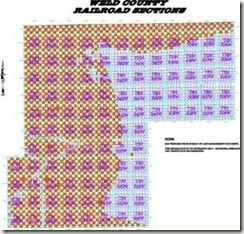Road Right of Way in Weld County
by Leon Sievers,
Professional Land Surveyor with the Weld County Public Works Dept.
RIGHT OF WAY DETERMINATION
In 1866, Section 2477 of the Revised Statues of the United States provided: “The right of way for the construction of highways over public lands not reserved for public uses is hereby granted”. It was also known as the Mining Act and the Canal Act. In 1885 an act by the Colorado General Assembly gave the right to County Commissioners to declare any section line or township line on the public domain a public highway. On October 12, 1889, the Board of County Commissioners of Weld County declared all section and township lines on the public domain of the United States in Weld County to be public highways. This order was recorded at the Clerk and Recorders Office in Book 86 at page 273. With this order, 60’ of road right of way, 30’ on each side of the section or township line, came into existence as long as the land was still in the public domain as of October 12, 1889. Examples of lands not in the public domain are:
Railroads sections
Through the Railroad Acts of the 1860’s and 1870’s, railroads were given land to offset the costs of construction. The railroad was given authority over the lands including reserving the land for sale. They were given every other section, mostly odd numbered sections. They were originally given sections up to 20 miles from the main line track on each side, but later were allowed to receive extra sections for land to compensate for those sections that was already taken out of the public domain. The railroad filed a map with the General Land Office showing the sections they claimed. A handmade copy of that map is displayed below. Notice that not all odd numbered sections were railroad sections. Since the map was filed prior to 1889, the railroad sections are considered to have been taken out of the public domain and not part of the 1889 Order of the Board of County Commissioners. In Weld County, the map and the Railroad Grant that authorized the land pertained mostly to the main line tracks of the Union Pacific Railroad. Later smaller spur lines were constructed by various railroad companies. Right of Way for these spur lines was secured by the railroad through various means, including fee simple ownership, easements and right of way grants with reversion clauses. There were times when all three options were used within a short distance of track.
 School sections
School sections
The 1863 Homestead Act reserved sections 16 and 36 for schools. The school sections were under the authority of the State Land Office and used the proceeds from the rental or sale of those lands for the construction and maintenance of schools. With sections 16 and 36, no student had to travel more than 2½ miles to school. Since this act took place in 1863, before the 1889 Order of the Board of County Commissioners, school sections were not part of the public domain. In 1921 a court decision stated that all roads on State/School lands prior to 1921 are public roads.
Homesteading
The Homestead Act allowed for the public to own property by staking a claim on that property, “proving up” the claim and receiving a “patent” or original deed for the property from the United States. The land, for the most part, had been initially surveyed with stones, pits and mounds, and charred stakes set at the section corners and quarter corners allowing for the homesteader to accurately locate and describe his property. The act of entering onto the property, along with filing a claim was enough for some to argue that the land was no longer in the public domain at that time. Others have argued that the patent date was the date the land was removed from the public domain. A check with the Bureau of Land Management records will indicate the patent date for the land in question. If the patent date is before the 1889 Order of the Board of County Commissioners, the land was not part of the public domain at the time of the order and the federal resolution did not apply to lands not still owned by the Federal Government.
ROAD PETITIONS: For those sections that were not part of the public domain on October 12, 1889, public Right-of-Way was given to Weld County in the form of road petitions. Local land owners would petition the Board of County Commissioners to construct a road along the section lines, or along some line specified in the petition. The Board would appoint “road viewers” to visit the location of the petitioned roadway. The viewers were instructed to prepare a report describing the route, determine costs for the road construction and determine the damages and/or benefits to the landowners because of the roadway. This report was presented to the Board for action. The Board would hear any complaint and would take action in the form of a statement declaring the road a public highway or deny the request.
Did You Know?
In 1885, an act by the Colorado General Assembly gave the right to County Commissioners to declare any section line or township line on the public domain a public highway.